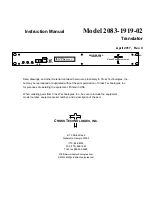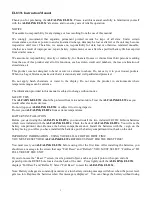
KDFX Reference
KDFX Algorithm Specifications
10-111
734 D Rotary
Small distortion followed by rotary speaker effect
PAUs:
2
D Rotary models an ampli
fi
er distortion followed by a rotating speaker. The rotating speaker has
separately controllable tweeter and woofer drivers. The algorithm has three main sections. First, the input
stereo signal is summed to mono and may be distorted by a tube ampli
fi
er simulation. The signal is then
passed into the rotator section where it is split into high and low frequency bands and the two bands are
run through separate rotators. The two bands are recombined and measured at two positions, spaced by a
controllable relative angle (microphone simulation) to obtain a stereo signal again. Finally the signal is
passed through a speaker cabinet simulation.
Figure 10-46
Block diagram of D Rotary
The
fi
rst part of D Rotary is a distortion algorithm. The distortion algorithm will soft clip the input
signal. The amount of soft clipping depends on how high the distortion drive parameter is set. Soft
clipping means that there is a smooth transition from linear gain to saturated overdrive. Higher distortion
drive settings cause the transition to become progressively sharper or “harder”. The distortion never
produces hard or digital clipping, but it does approach it at high drive settings. When you increase the
distortion drive parameter you are increasing the gain of the algorithm until the signal reaches saturation.
You will have to compensate for increases in drive gain by reducing the output gain. These algorithm will
not digitally clip unless the output gain is over-driven.
Next the signal passes through a rotating speaker routine. The rotating speaker has separately controllable
tweeter and woofer drivers. The signal is split into high and low frequency bands and the two bands are
run through separate rotators. The upper and lower rotors each have a pair of virtual microphones which
can be positioned at varying positions (angles) around the rotors. The positions of the microphones for the
upper and lower drivers is the same. The Mic Angle parameter sets the anglular position of the
microphones relative to the loosely de
fi
ned “front” of the speaker. There are microphones for left and right
outputs. As the Mic Angle is increased from 0°, the left microphone moves further to the left and the right
microphone moves further to the right. The signal
fi
nally passes through a
fi
nal lowpass and highpass
fi
lter pair to simulate the band-limiting effect of the speaker cabinet.
Figure 10-47
Rotating speaker with virtual microphones
Distortion
Rotator
Rotator
L Input
R Output
L Output
R Output
Out Gain
Cabinet
Содержание K2661
Страница 18: ...2 4 LFOs LFO Shapes...
Страница 34: ...3 16 DSP Algorithms...
Страница 54: ...5 4 MIDI Note Numbers Note Numbers for Percussion Keymaps...
Страница 72: ...7 10 System Exclusive Protocol K2661 System Exclusive Implementation...
Страница 82: ...9 4 Upgrading Sample Memory Choosing and Installing a SIMM for K2661 Sample Memory...
Страница 334: ...10 252 KDFX Reference KDFX Algorithm Specifications...
Страница 340: ...11 6 Glossary...
Страница 382: ...12 42 Triple Modular Processing Alphanumeric Buttonpad Entries for DSP Functions...
Страница 392: ...B 6 SysEx Control of KDFX MSB and LSB...
Страница 442: ...D 20 Contemporary ROM Block Objects Controller Assignments Contemporary ROM Block...
Страница 490: ...H 12 General MIDI Standard Mode Controller Assignments...
Страница 492: ...I 2 Live Mode Objects Live Mode Programs...
Страница 498: ...K2661 Musician s Reference Index...
Страница 500: ......
















































